Spain Hispanic Day – October 12, 2022, history, significance
Spain Hispanic Day is celebrated every October 12 to mark Christopher Columbus’ first landfall in the Americas. Did you know that Columbus was seeking a direct route to Asia when he discovered the Americas?
Spain Hispanic Day, also known as Fiesta Nacional de España or Día de la Hispanidad, is an official holiday in most Hispanic America under different names. All government administrative buildings and offices, banks, and stores are closed for the day. Learn about the historical significance of this day in Spain.
HISTORY OF SPAIN HISPANIC DAY

Christopher Columbus’ discovery of the Americas significantly changed the continent and Europe, making Spain the first modern superpower and shaping the Americas’ ethnic, cultural, and political landscapes. Columbus’ first voyage to the New World began on the evening of August 3, 1492. He left the harbor of Palos de la Frontera with three ships: Santa Maria, the Pinta, and the Niña, with Christopher Columbus traveling on the first ship.
On October 12, 1492, the crew on the Pinta sighted land and informed Columbus. Then, Columbus and his men landed on an island and were received by the indigenous Arawak people. He later named the island San Salvador, though it was called Guanahani by the locals. He also referred to the indigenous people as Los Indios, creating a generalized term that will be used to describe the indigenous people of North, Central, and South America.
Columbus later continued his voyage, exploring northeast of Cuba and the northern coast of Hispaniola. In December of that year, Columbus founded the settlement of La Navidad in present-day Haiti and left 39 men there, after the permission of the local chief. On March 15, 1493, Columbus arrived in Spain with native prisoners. His discoveries were received with great celebration and quickly spread across Europe.
On September 24, 1493, Columbus set sail for the New World with 17 ships and about 1500 men. During this voyage, he encountered the islands of Dominica, Maria-Galante, Montserrat, Antigua, the Virgin Islands, and more. In November 1493, he returned to Hispaniola and established a temporary settlement in La Isabela, present-day Dominican Republic.
The Spanish settlers soon introduced the encomienda system, where indigenous people provided labor for the Spaniards in return for food, shelter, and protection. That, along with the introduction of European diseases and the exportation of enslaved locals, led to a drastic reduction in the indigenous population.
Columbus set sail again on May 30, 1498, locating the regions of modern-day Central and South America. In 1499, Columbus was accused of tyranny and corruption. He and his brother were arrested, shipped to Spain, and spent six weeks in jail. The Columbus brothers were later absolved of all charges by King Ferdinand and Queen Isabella and got sponsored for their fourth voyage to the New World.
On May 9, 1502, Columbus returned to the Americas with a fleet of 30 ships, but only one made it back to Spain. During this voyage, Columbus explored the coasts of Honduras, Nicaragua, and Costa Rica. However, he was impeded by a storm and shipwrecked in Jamaica, where they remained stranded for six months.
In a desperate attempt to induce the natives to keep providing for him and his men, Columbus used the lunar eclipse of February 29, 1504, to scare them. He accurately predicted the event using Abraham Zacuto’s astronomical charts. On June 28, 1504, he and his men were rescued, and they arrived in Spain on November 7, 1504.
SPAIN HISPANIC DAY TIMELINE
1492 — 1493
The First Voyage
Columbus sets sail in search of Asia, exploring San Salvador in the Bahamas, the northeast coast of Cuba, Hispaniola, and Haiti.
1493 — 1496
The Second Voyage
Columbus returns to the New World, encountering the islands of Dominica, Antigua, Montserrat, and more.
1498 — 1500
The Third Voyage
Columbus sights Trinidad, Venezuela, Tobago, and Granada.
1502 — 1504
The Fourth Voyage
Columbus explores the coast of Honduras, Nicaragua, and Costa Rica.
SPAIN HISPANIC DAY ACTIVITIES
Take a trip to Spain
The day’s celebrations usually extend up to a week, giving people an opportunity to travel to the countryside and explore historical places in Spain. Common destinations for this trip include Aragon and Zaragoza. Book your flight early so you don’t miss out on the celebration.
Learn Spanish
Spanish is the second most widely spoken language in the world. It’s relatively easy to learn, and there are many courses and tutorials available online for those interested. If you love a gamified way of learning, you can start with apps like Duolingo.
Try a Spanish dish
Dishes such as tortilla Española, gazpacho, paella Valenciana, and fideuá are some of the best the Spanish nation has to offer. Check for a nearby Spanish restaurant and indulge your taste buds with these delicious Spanish cuisines.
5 INTERESTING FACTS ABOUT SPAIN
No lyrics
The ‘Marcha Real,’ Spain’s national anthem, is one of four national anthems in the world with no lyrics.
Border with an African country
Spain is the only country in Europe to have a border with Africa through Morocco.
UNESCO World Heritage Sites
Spain has the third-highest number of UNESCO World Heritage Sites globally — 47.
Spanish speakers
There are about 440 million native Spanish speakers globally, making it second only to Mandarin Chinese.
The world’s oldest restaurant
El Restaurante Botín in Madrid, opened in 1725, is the oldest restaurant in the world.
WHY WE LOVE SPAIN HISPANIC DAY
Sightseeing
For a week, we can travel to historical and symbolic places in Spain. Visit these landmarks alone or with family and friends.
Spanish legacy
Aside from the Spanish discovery of the Americas, Spain Hispanic Day also celebrates its impact and influence over the Americas, especially Hispanic America. Learn all about Spain’s legacy today!
Unity
Spain Hispanic Day is also a celebration of Spanish culture and language. It commemorates the shared history between Spain and other Spanish-speaking countries, deepening social, political, and economic ties.



